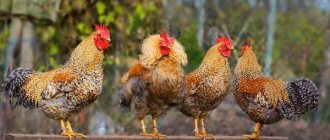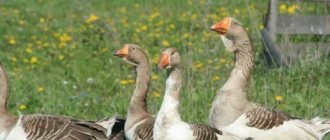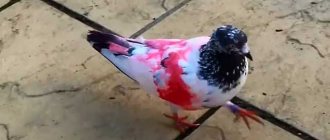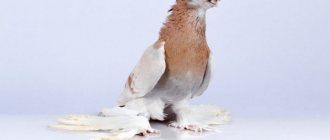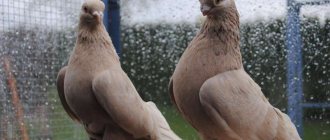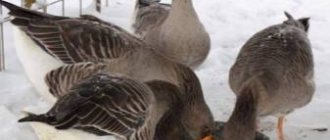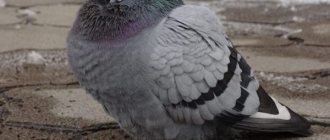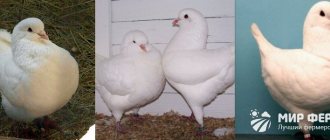Breeds of wild pigeons
Despite the advance of civilization on nature, wild species of pigeons are found in different regions of the world. About 300 species of this bird are known. Natural species differ from their domestic counterparts in their smaller size.
Klintukh
A close relative of the urban rock pigeon. Habitats: temperate latitudes of the European continent, western Siberia, northeastern Africa.
Advantages and disadvantages
large head, short tail;
often nests in hollows made by other birds;
weight – 300 grams, wingspan – 65-70 centimeters.
It is difficult to see the bird due to timidity and caution.
Clintukhi can lead a sedentary lifestyle or fly away to warm regions for the winter.
Rocky
There are 2 subspecies, both common in Russia. The small bird is smaller than the sizar. Lives in the Asian region.
Advantages and disadvantages
settle in rocks, mountain cavities, caves;
very dexterous, nimble, excellent flyers.
live away from people;
difficult to tame.
Rock pigeons are graceful, medium-sized, females are more agile and faster than males.
Crowned
They live only in Guinea and nearby islands.
Advantages and disadvantages
live in forests, feed on plant fruits and snails;
females are almost no different from males.
a rare species living in a limited range.
Crowned pigeons live up to 20 years.
Gray
The bird weighs up to 380 grams. When people explored new lands, they took rock pigeons with them, so they are widespread everywhere.
Advantages and disadvantages
flight speed – 160-180 kilometers per hour;
walks well, the stride is wide and stable;
can dive into deep wells or crevices for water.
They get along easily with people and become annoying in cities.
Rock pigeons are the most common bird species in cities and villages. They live 3-5 years.
Wood Pigeon
This species has an impressive size - up to 900 grams. Settles on the branches of large trees.
Advantages and disadvantages
wingspan - 60-70 centimeters;
gray-red breast, greenish tint of feathers on the neck;
flies well.
the population is small in most habitats.
Lives in temperate regions of Europe, Western Siberia, and the northeast of the African continent.
Expert opinion
Zarechny Maxim Valerievich
Agronomist with 12 years of experience. Our best country expert.
Ask a Question
Information: pigeons are mentioned in the holy books of Christians and Muslims. The bird brought the news to Noah about the completion of the ark's voyage, the dove gave Muhammad water and saved the prophet from thirst.
What is a species: a little general biology
In animals, including birds, a species is the main structural unit of taxonomy. The species must meet the following characteristics.
General signs
Morphological, physiological, behavioral. In relation to pigeons, this means: any bird that looks like a pigeon, behaves like a pigeon, and eats the same things as other pigeons, is logically classified as pigeons - until deeper and more characteristic differences are found.
Ability to mutually fertile crossbreeding
This is the key point. If it is possible to get offspring from two birds, which then reproduce on their own without any problems, then both birds belong to the same species. On the contrary, reproductive isolation (a situation when there are no offspring or sterile hybrids are born that no longer produce their offspring), even with very great similarities, means that these are two different species.
With regard to pigeons, we can say: all purebred domestic pigeons and wild ones that live on city streets, in parks or in rural areas are one species. If you bring together a purebred pigeon from an elite nursery and a street wild male, the chicks that may be useless for breeding will be hatched, but they will be viable and vigorous.
Basic information that a poultry farmer needs to know about the physiology of pigeons
Read
Breeding pigeons for meat as a business. Nuances of the organization and real income figures
More details
Rules for keeping pigeons: what should be in the dovecote and how to organize the feeding regime
Article
Other signs
Other characteristics of the species include:
- General habitat.
- General history of evolution, similar signs of adaptation to the environment.
- Similar DNA code. This trait began to stand out only in the last decades of the last century after genetics had made serious progress. It is genetics that sometimes puts the final point in biologists' disputes about whether two groups of animals are one species, a species and a subspecies, or whether their similarity is purely coincidental.
Sometimes it is not possible to cross two different species precisely because of differences in behavior. For example, wood pigeons and domestic pigeons are genetically compatible - but pigeons and doves do not accept male and female wood pigeons as mating partners precisely because they “do not behave like that.”
Incubation of pigeon eggs: features of the process and what to do after the chicks hatch
Read
Breeding pigeons at home for beginners. How to gain experience
More details
TOP 20 most famous breeds of domestic pigeons
Article
Postal (sporting) breeds
In the absence of the Internet or even regular mail, pigeons were used to deliver letters. Mail breeds have lost their relevance in direct use; they are bred for pleasure.
English quarry
Tall slender birds, the beak is surrounded by skin growths. Brought to England from Eastern countries, purposefully bred for postal purposes.
Advantages and disadvantages
body height – up to 45 centimeters;
strong long beak standing horizontally;
the plumage fits tightly to the body and is rigid.
Skin growths near the beak and eye rings need to be taken special care and washed.
Now they are bred for decorative purposes. Plumage colors vary.
Belgian postal
Belgian postal pigeons are fast and hardy. They easily cover long distances.
Advantages and disadvantages
slender, with a harmonious body, a medium-sized head;
cheerful and temperamental;
muscular chest.
purebreds are expensive.
Different colors are allowed.
Pigeons and man
Pigeon meat
Man domesticated the wild rock pigeon more than 5,000 years ago, and possibly 10,000 years ago. Since then, pigeon breeders have bred more than 800 breeds of domestic pigeons, varying in color, body shape and purpose.
In Russia there are about 200 breeds of pigeons of domestic origin.
Application of pigeons:
- Domestic pigeons are bred for meat. There are specialized meat breeds.
- Pigeon mail has long been one of the main methods of postal communication.
- Pigeons were also used for aerial photography.
- In earlier times, pigeons were used for pigeon hunting.
Characteristics of the main breeds
Budapest high flying circles
They fly in a dense flock. The best flocks should be so dense that not a single individual can break away from them, and the flight of the Budapest high-flyers should continue for at least 5 hours in the field of view and another hour out of it.
This bird has a lively temperament and is of medium size. The head is smooth, the beak is of medium thickness with a curved tip. The neck is set vertically. Broad chest, slightly raised. The wings, although medium in size, are powerful and strong, their tips reaching the outer tail feathers. The tail is a continuation of the line of the back, slopes downwards, but there is no contact with the floor. Limbs are short. Featherage is not a stable indicator. According to the color scheme there are: white, stork, white with a wreath on the neck, waist-length.
Budapest pigeons love to fly in dense flocks.
Perm
Perm high-flyers fly without performing figures. In the skies over the Urals and Siberia they can be seen more often than other breeds, and, as a rule, alone. A medium sized bird with a very well developed muscular system. The characteristic low carriage of the head distinguishes this breed from others.
At high altitudes, Permian pigeons can stay for up to 6 hours.
Among the Permian there are also white-headed ones, flying in groups at medium altitude.
Birds of the Permian breed fly high, but are not able to perform complex figures in the sky.
Pigeons of the Kama region
High-flying pigeons of the Kama region have different subspecies, but all these birds are medium-sized. Good spatial orientation, variety of flight styles, excellent parental instincts make this breed valuable and desirable.
The flight of a butterfly and the sickle flight are what pigeon breeders value and cherish the breed for. And the ease of maintenance, unpretentiousness in food and conditions allow it to conquer more and more new habitats.
Prikamsky pigeons are sickle pigeons, so they are very beautiful when flying.
Mordovian
Birds of this breed are motley or have white plumage. Excellent orientation and long circular flights of up to eight hours at medium altitudes. Steady high flight is not typical for them, but sometimes these birds move upward from medium altitudes and “melt” into the sky.
Birds of the Mordovian breed are distinguished by their motley plumage and small size.
Serbian
Tufted and bare-footed tumblers, according to some, were bred in Belgrade, but other experts claim that they were brought by the Turks.
A bird that can fly for 10 hours. Of course, this applies to individual specimens, and the average time is 5 - 8 hours.
The pigeon has a medium-sized head with a crest on the back of the head. The very dense short neck quickly turns into the chest. The wings are long. Limbs are bare, of medium length. The color is one color, usually black, red, blue.
Birds of the Serbian breed are capable of staying in the sky for up to 10 hours in a row.
Bugulma
This breed is also called hryvnias. A standard for it has not been developed. A black mane flaunts on a pure white background. Sometimes there are birds of a single color. Graceful and at the same time hardy, with a strong constitution.
Bugulma (as this bird is sometimes called) flies for a long time. At first the flock circles together. Then the most experienced and strong soar up, and those who are weaker descend.
Bugulma pigeons will not take root in someone else's dovecote. They remember the way home perfectly.
Bulgumin pigeons are not only excellent flyers, but also have an attractive appearance.
Hungarian
Hungarian pigeons are simple in appearance, but have a strong build. These birds “stand on the wing” for 8–10 hours.
The breed is often kept as a "nurse". They are excellent at incubating and feeding their offspring, and are undemanding when it comes to food and living conditions. Having excellent memory and orientation, they almost always return to their dovecote, even several tens of kilometers away.
Hungarian pigeons are low maintenance and take good care of their offspring.

